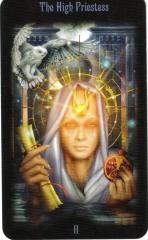The Middle Way of Tarot
 There is a lot of misunderstanding of tarot in the world. Some of it comes from well-intentioned tarotists.
There is a lot of misunderstanding of tarot in the world. Some of it comes from well-intentioned tarotists.
For once, I am not talking about the Gypsies who use tarot to swindle their clients. We already know they are propagators of misunderstanding. I am referring to smart, spiritual tarot students and practitioners who haven’t yet found the sweetest spot of tarot interpretation and understanding – the Middle Way.
The concept of the Middle Way (or the Middle Path) is Buddhist, although its tenets show up in many philosophical teachings. A secular way to describe it is the happy medium, which is also a great play on words when talking about tarot.
The idea of the Middle Way, as I understand it, is that we find enlightenment in the right balance, rather than when we delve into any particular extreme.
Many tarot cards speak directly to this spiritual concept of right balance. Those cards include the High Priestess, the Two of Pentacles, Justice and Temperance.
But what does this have to do with understanding the concept of tarot reading?
I have noticed that there exists amongst tarot students and practitioners those who believe intuition is all that is needed to read tarot. Study is an unnecessary burden and memorization is a waste of time.
There are also those tarotists who espouse the diametric opposite of that concept by insisting a particular card means exactly one thing – the same thing – each and every time it appears. For those readers, a singular clearly memorized definition for each card is the whole of tarot interpretation from which none should stray.
I think the truth is somewhere in the middle, between these two limited philosophies.
To those who feel that tarot is about intuition, and only intuition, I say this. Yes, a brand new reader can find truth simply by looking at the cards. Yes, there are skilled intuitive professional readers who use tarot to inspire their readings even though they haven’t a clue about the traditional interpretations associated with each card.
But to say that intuition is the whole of tarot reading is like saying use of a scalpel is the whole of performing surgery. Some surgeries require only a scalpel. Every surgeon must know how to wield a scalpel. But surgeons need to use other tools in addition to scalpels or else they are dangerously limited in their skills.
The didactic memorizers are just as limited. It is crucial to understand some traditional interpretations for each card. However, we must leave room for the great number of possible interpretations, and for the play of intuition. Circumstances matter a lot. For example, we know that the Page of Cups could indicate a young child. But if a happily childless adult person were to ask the cards “What is my greatest challenge?” and receive the Page of Cups, “a young child” is not a great answer. But perhaps “learning to express your heart,” another interpretation for this card, would make perfect sense.
In this case, study provides the possible answers, while intuition picks the right answer.
Intuition works with tarot in other ways, too. It may draw our eyes to a particular image within a card, or inspire us to pay attention to the way two cards blend. It may give us psychic information beyond what we see in the cards.
Study offers us the opportunity to learn a wide variety of possible interpretations and depictions for each card. Rather than being confused and frustrated by the number of possibilities (and the fact that some of those possibilities are in conflict) we need to embrace all of the possibilities. Then we can allow intuition, circumstance and neighboring cards to sharpen our interpretations.
Study also allows us to understand the synchronicities of the cards. We learn a great deal when we explore the symbolic, elemental, astrological, numeric, archetypal and Kabalistic associations of tarot. We find deeper meaning in the cards, and learn to use tarot as a book of spiritual wisdom, as well as a tool of divination.
Tarot cards are designed to help us open the third eye and become more psychic. The more we study tarot, the more psychic we will be. To try to choose either study or intuition makes no sense because tarot study and intuitive reading work together to enhance each other.
To get the most out of tarot reading, whether as a student, a hobbyist or a professional, we need the Middle Path. If we are all intuition and no study, we lose the spiritual message of the cards and the benefit of their tradition. If we rely only on simple memorized key words we are missing the depth of meaning and wealth of information that a tarot reading can offer.